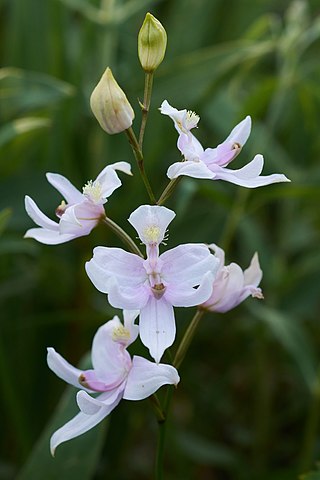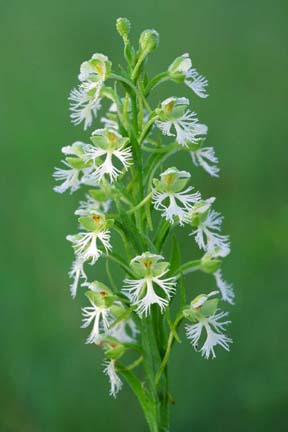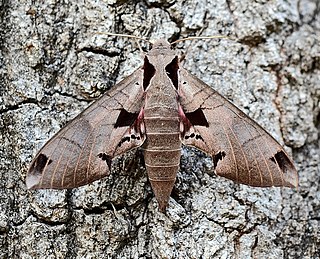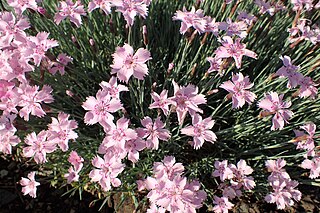
Flatwoods, pineywoods, pine savannas and longleaf pine-wiregrass ecosystem are terms that refer to an ecological community in the southeastern coastal plain of North America. Flatwoods are an ecosystem maintained by wildfire or prescribed fire and are dominated by longleaf pine, and slash pine in the tree canopy and saw palmetto, gallberry and other flammable evergreen shrubs in the understory, along with a high diversity of herb species. It was once one of the dominant ecosystem types of southeastern North America. Although grasses and pines are characteristic of this system, the precise composition changes from west to east, that is, from Texas to Florida. In Louisiana, savannas even differ between the east and west side of the Mississippi River. The key factor maintaining this habitat type is recurring fire. Without fire, the habitat is eventually invaded by other species of woody plants.

Calopogon oklahomensis, commonly known as the Oklahoma grass pink or prairie grass pink, is a terrestrial species of orchid native to the United States. It is restricted to the states of Alabama, Arkansas, Georgia, Illinois, Indiana, Iowa, Kansas, Louisiana, Minnesota, Mississippi, Missouri, Oklahoma, South Carolina, Tennessee, Texas, and Wisconsin. It is extirpated throughout most of its range. Calopogon oklahomensis is a perennial herb with flowers that are white, pink or purple, with a labellum with an apical region of yellow hairs. Flowers bloom March to July. Its habitats include coastal prairies, savannas, edges of bogs, and oak woodlands. It was described by Douglas H. Goldman in 1995.

Cranberry Glades — also known simply as The Glades — are a cluster of five small, boreal-type bogs in southwestern Pocahontas County, West Virginia, United States. This area, high in the Allegheny Mountains at about 3,400 feet (1,000 m), is protected as the Cranberry Glades Botanical Area, part of the Monongahela National Forest. This site is the headwaters of the Cranberry River, a popular trout stream, and is adjacent to the nearly 50,000-acre (200 km2) Cranberry Wilderness.

Platanthera leucophaea, commonly known as the prairie white fringed orchid or eastern prairie fringed orchid, is a rare species of orchid native to North America. It is a federally threatened species, protected since October 30, 1989 under the Endangered Species Act of 1973. In Canada, it has been listed endangered under Schedule 1 of the Species at Risk Act since 2005. In 2014, the International Union for Conservation of Nature assessed it as "least concern."
Helleborine is the common name for a number of species of orchid. It does not correspond to any currently used taxonomic category. Some of the plants called helleborines are classified in the genus Epipactis, some in genus Cephalanthera. A genus Helleborine was formerly recognised but has now been absorbed into the Grass pink genus Calopogon.

Cypripedium acaule is a species of flowering plant in the orchid family Orchidaceae native to eastern North America. It is the provincial flower of Prince Edward Island, Canada, and the state wildflower of New Hampshire, United States.

Calopogon tuberosus, the tuberous grass pink, is an orchid native to eastern North America.

Eumorpha achemon, the Achemon sphinx, is a moth of the family Sphingidae. The species was first described by Dru Drury in 1773.

Sabatia angularis, commonly called rosepink, rose pink, square-stem rose pink or rose gentain is a biennial flowering plant in the Gentianaceae (gentain) family. It is native to central and eastern North America.

Primula meadia, known by the common names shooting star, eastern shooting star, American cowslip, roosterheads, and prairie pointers is a species of flowering plant in the primrose family Primulaceae. It is native to the eastern United States and Canada, spanning north from Manitoba and New York, south to Texas and Florida.

The many-flowered grass-pink, Calopogon multiflorus, is a species of orchid. It is a perennial forb that requires recurring ground fires to maintain its habitat. It falls under the genus Calopogon, meaning "beautiful beard" in Greek, referring to the stamen-like bristles or beard on the lip.

Cypripedium reginae, known as the showy lady's slipper, pink-and-white lady's-slipper, or the queen's lady's-slipper, is a rare lady's-slipper orchid native to northern North America. Although never common, this plant has vanished from much of its historical range due to habitat loss. It is the state flower of Minnesota.
The Burrinjuck Nature Reserve is a protected nature reserve on the south west slopes of New South Wales, Australia. The 5,250-hectare (13,000-acre) reserve is located adjacent to the Burrinjuck Dam, with 5,118 hectares of the reserve located on the northern side of the reservoir, and the remaining 89 hectares located on the southern side of the reservoir to the northeast of Black Andrew Nature Reserve. It includes land formerly managed as the Burrinjuck State Forest and Burrinjuck State Recreation Area.

Agalinis skinneriana is a species of flowering plant in the family Orobanchaceae known by the common names Skinner's gerardia, Skinner's false foxglove and pale false foxglove. It is native to North America, where it occurs in Ontario south to Missouri and Louisiana.
A cataract bog is a rare ecological community formed where a permanent stream flows over a granite outcropping. The sheeting of water keeps the edges of the rock wet without eroding the soil; in this precarious location no tree or large shrub can maintain a roothold. The result is a narrow, permanently wet, sunny habitat.

Asclepias quadrifolia, commonly called four-leaved milkweed or fourleaf milkweed, is a species of milkweed in the Apocynaceae (dogbane) family. It is sometimes referred to as whorled milkweed, but it should not be confused with Asclepias verticillata. A. quadrifolia occurs in the eastern United States and Canada.

Calopogon barbatus, the bearded grass-pink, is a species of orchid native to the southeastern United States, from Louisiana to North Carolina.

Dianthus plumarius, also known as the common pink, garden pink, wild pink or simply pink, is a species of flowering plant in the family Caryophyllaceae.

Sisyrinchium albidum, commonly known as white blue-eyed grass, is a species of flowering plant in the family Iridaceae.

Symphyotrichum elliottii is a species of flowering plant in the family Asteraceae native to the southeastern United States Atlantic coastal plain where it grows in wetland areas. Commonly known as Elliott's aster, it is a perennial, herbaceous plant that may reach 6 to 20 decimeters tall. Its flowers have pink ray florets and pale yellow, then pink, then brown disk florets. NatureServe, as of July 2021, classified S. elliottii as Apparently Secure (G4) globally, and of conservation concern in North Carolina, South Carolina, and Virginia.


















